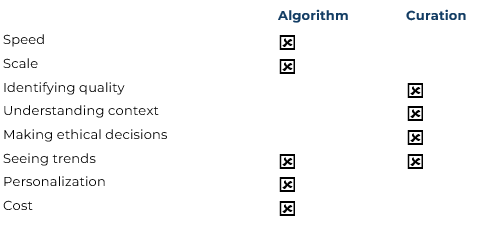January 2024 Issue
Dear Publishing Professional,
For this first letter of the New Year, I focus on trends that publishers should keep in mind in 2024.
The rise of questions
AI chatbots are killing traditional search and creating the option to have conversational interactions with computers. I recently opened the ChatGPT app on my phone and had a conversation about a book idea while driving around town. It was both interesting and useful, and a hundred times better than anything I could have done with a Google search.
People will learn to expect this kind of interaction so you should consider building your own large language model to enable your customers to ask questions against your content and get answers in your voice and from your point of view.
You can also leverage this process to learn about your audience based on the questions they ask. Questions reveal a lot about the worries, state of mind, and needs of your market.
Don’t forget that questions can go both ways. Asking questions of your audience can help you gather data and fine-tune ideas, but it can also help with engagement.
Personalized AI agents and publishing
New technologies often create a need for a new user interface. It’s very likely that generative AI is going to change the way we interact with our phones and our computers.
While augmented reality, virtual reality, and even brain-computer interfaces have to be considered, a more modest and likely scenario would go like this.
Your phone will have a personalized AI agent – like your newsfeed on steroids. It will collect the information you want to see, in the format you prefer, within the budget you specify. It will note your stated preferences, but it will also adjust based on your behavior. It will manage things like subscription offers and paywalls on your behalf. After reviewing options that fit with your preferences, it might give you a message like this.
Based on your reading habits and preferences, increasing your budget for news content by $5 per month will vastly improve your reading experience and satisfaction. Shall I implement this increase?
This isn’t going to happen suddenly or soon, but something along these lines is on its way, and publishers should consider how content distribution, pricing, marketing offers, and e-commerce will be affected.
5 easy things to test in your use of AI
- Do AI-generated summaries of an article increase time spent on the page? (If you don’t edit them, be sure to disclose that they’re created by AI.)
- Are AI-generated images more or less effective than stock images?
- Who’s better with prompts? Don’t only test AI-generated art against stock images. Also test Sally’s AI-generated art against Frank’s.
- Are different styles of images more effective (e.g., watercolor, minimalist, art deco, abstract, etc.). AI art engines can create art in many different styles.
- Does one engine do better than another (e.g., DALL•E vs. Midjourney)?
Fluid customer relationships & customer value
Content creators are often told we need to be everywhere – in podcasts, on YouTube, X, Instagram, LinkedIn, e-newsletters, and by the time you get this letter, five new things. It’s hard to track customer engagement and value in such a fluid environment.
“It’s easier to keep a customer than get a customer,” but how do you know whether you’re “keeping a customer” when they can move from one channel to another, e.g., from your e-newsletter to your podcast? An email sign-up or unsubscribe is trackable to the person, but a new podcast follower is usually anonymous.
Before you invest too heavily in the “everywhere all the time in any format” mentality, give some thought to how that will affect your ability to track customer value. In some cases, knowing who your customers are can be more valuable than having more of them.
Are your customers consumers or creators?
Technology has lowered the barrier to entry for creators, which has resulted in an explosion of content. Most of this content has been poor quality, but AI is helping people with modest skills do very good work. While some expect a tsunami of garbage, it’s very likely there will (also?) be a big wave of high-quality material.
One possible response is to find ways to use AI to help creative humans make new things.
An example. Decades ago, I helped create an online employee handbook builder. It asked some preliminary questions about relevant jurisdictions and HR policies, then created a custom handbook that the user could personalize. Think how much better that could have been with AI tools?
Home Depot says “you can do it. We can help.” Can a publisher follow that model and find niches where it can leverage its own subject matter expertise to help people use AI tools to create their own thing?
Remember: when everyone’s starting a band, don’t start a band. Sell band equipment.
Read old advertising books
The publishing world has recently seen some remarkable studies that cast doubt on the reliability of online marketing data. The Association of National Advertisers released a report on the programmatic supply chain. It said only 36 percent of ad spending on demand-side platforms actually reaches the advertiser’s intended audience. Bob Hoffman thinks the numbers are far worse than that. He estimates that 3 percent of digital ad spend corresponds to actual ads seen by humans.
There are a lot of reasons for this, from outright fraud to tech glitches to various kinds of human error. This doesn’t mean that advertising is bad, only that programmatic advertising may not be doing what people think it’s doing – that “tracking” and behind-the-scenes wizardry is not as reliable as we’ve been led to believe.
The new breed of marketers have been raised on the idea of “data-driven marketing,” but the data for online ads might all be junk. Or at least mostly junk.
Advertising was a successful and useful enterprise way before anyone could dream of “programmatic.” Maybe it’s time we learned from the people who made it work back then.
Advertisement  |
Talk to your customers
“Cold hard data” is great and can transform a business, but there’s a big downside to over-reliance on data. Without a human context, it’s easy to make all the wrong conclusions from analytics. For example, if a lot of people use the search function on your website, that could mean you have a great search engine, or it could mean your site isn’t organized very well. Check your data-driven assumptions against real-world experience.
- Incentivize your staff to speak with customers, but be sensitive to personality differences. Some people would rather quit than be forced to talk to someone.
- Find ways to optimize the contacts you already have, such as customer service or support requests.
- Send your employees to events where they can meet customers face to face.
- Identify your “super users” and interview them.
Don’t make decisions based on a few anecdotes, but don’t trust conclusions you think you can draw from your data until you’ve verified them with real people.
Quick takes
- Demand for audio content continues to grow. If you major in text, consider using text to speech technology. I haven’t used any of these, but look at Lovo.ai, Speechify, and Murf.
- A slogan for printers and booksellers? “Print. It’s the thinking man’s internet.”
- When you do a search on a topic, like “what are the elements of a strategic plan?” be sure to do an image search as well. A model, framework, or diagram can help organize a concept and give it structure.
- Don’t be afraid to have a perspective, a point of view, and a unique voice. That can be an important differentiator.
- Ask yourself and your staff, “What does success look like for our customers? How is our product essential to that success?”
- Strategy: now more than ever. It’s been my observation that publishers don’t spend enough time on strategic thinking. The changing landscape for publishers has made it more necessary than ever. Every aspect of publishing is likely to change in the next few years. How are you preparing? How can I help you?
Curation versus the algorithm
In an end of the year message, Bo Sacks said one of the core strengths of publishers is their trust of curation over the algorithm. I think he’s excluding the annoying click-bait side of publishing, but he raises an important point that will be increasingly relevant in the coming years. Publishers need to think about the relative merits and uses of curation and algorithms.
Algorithms are good things. Social platforms like LinkedIn or X can’t reasonably show all the posts a reader might be interested in. They need the algorithm to make predictions.
Curation serves a different function. It’s the human touch on a smaller scale.

A couple notes. Algorithms are based on past behavior, so they might not see trends as well as a human. On the other hand, computers can find patterns that humans don’t see.
It’s odd to think that a computer would be better at personalization, but personalization is a matter of data and scale, two things the computer excels at.
Sincerely,

Greg Krehbiel
240-687-1230
P.S. – I’m wishing each of you a very prosperous 2024! Please let me know if there’s any way I can help you succeed.

“The Krehbiel Group” is usually just me, Greg Krehbiel. But from time to time I engage people to help. Here are some things I (we) can do for you.
- Help you evaluate, onboard, or manage a Customer Data Platform.
- Teach your marketing and IT staff to get along and get things done!
- Review and improve your engagement, retention, and renewal efforts.
- Evaluate a new technology on your behalf.
- Promote your product or service in this newsletter.
- Manage a strategic planning process for you and your staff.
- Interview you on my podcast.
- Review your operations and increase your efficiency.
- Optimize your e-store.
- Evaluate your website analytics.
- Create content marketing material for your product or service.
- Speak at your event.
- Manage a technical project. (Create an app, build an API ….)
- Be a guest on your podcast.
- Train or mentor your junior marketing/tech staff.
- Provide a sanity check.
But honestly, I’ve been in publishing my whole career. I can probably help with anything you need. Or I can point you in the right direction. Let’s talk!
